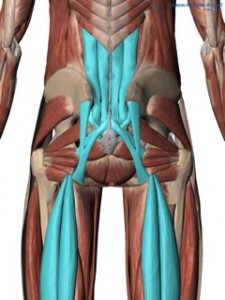Hamstring imbalances, one side compared to the other, is very common and can be a source of a lot of issues for the athlete.
 So lets be super general here. This is a BIG FAT TOPIC.
So lets be super general here. This is a BIG FAT TOPIC.
Let’s go with the imbalance as a matter of anatomy and habit. A lot of the times, one leg is dominate. One quad is dominant. Stronger. So the other leg, a bit weaker, etc. This creates imbalances that have affects with both hips/ball and socket joints. They come habit, how the hips function. This concept is generally why one hip hurts more than the other. One is “less centered” in the joint than the other.
For me personally, my right leg is dominant. As a soccer player for years, you can imagine the fascial patterns and muscle development. Not to mention the wear and tear…It wasn’t until I started seriously practicing yoga that I really became aware, aware of why and aware of what to do about it. Pretty soon found myself pain free. So off I go learning more. Now I know that I pronate more on one foot more than the other, which has affects along the kinetic chain.
Little things like driving in a car a lot. Sometimes your putting more pressure on one hamstring than the other. Due to how the seat is built. Or you’re sitting in the seat with bad posture. Pressing the gas pedal with the same foot all the time has affects. Sitting on one leg habitually at work has an affect. You get the point.
Your physical habits have a big impact on our training. Sometimes it isn’t the training, it’s the lazy habits, and the training brings up the affects in a BIG FAT WAY. So is it your run form, or your desk form. 🙂
 Let’s chat a second about the pelvis. Think of it as a bowl. It can tilt in four directions. It’s not a stable as everyone thinks. And can get “stuck” fascialy speaking due to this and that. Moms, you know what I’m talking about. The heavy baby on one hip is classic. Heavy purses on one shoulder. So it’s not as “stable” as what we think.
Let’s chat a second about the pelvis. Think of it as a bowl. It can tilt in four directions. It’s not a stable as everyone thinks. And can get “stuck” fascialy speaking due to this and that. Moms, you know what I’m talking about. The heavy baby on one hip is classic. Heavy purses on one shoulder. So it’s not as “stable” as what we think.
Let’s put the “back” into this conversation. If you have one hamstring tighter than the other, generally speaking, the opposite side of your back will be tighter. And since I can resist, the opposite shoulder/neck of that (generally speaking) will be a troubled spot as well. BECAUSE ITS ALL CONNECTED. The back is trying to straighten things out. As the picture above shows you, the pelvis can tilt laterally. The back will try and straighten it out. Which causes the shoulder/neck to go the opposite way.
So things get tight, and tighter and tighter. BOOM.
Disc issues. Spine issues. Inflammation. Herniations. Pain meds.
Loss of quality of life.
MOST FROM SOFT TISSUE IMBALANCES
Easy thing is ….
YOGA has the means to help you identify the issue.
Yoga has the means to help you address it in a smart way.
HOW FANTASTIC IS THAT!
Try this video out!
